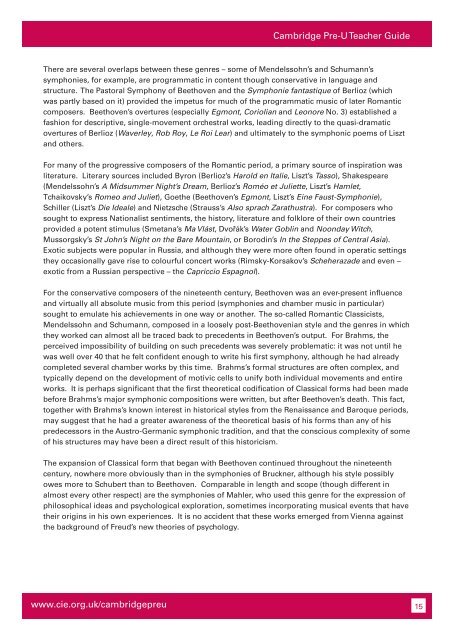Teacher's Guide Cambridge Pre-U MUSIC Available for teaching ...
Teacher's Guide Cambridge Pre-U MUSIC Available for teaching ...
Teacher's Guide Cambridge Pre-U MUSIC Available for teaching ...
You also want an ePaper? Increase the reach of your titles
YUMPU automatically turns print PDFs into web optimized ePapers that Google loves.
<strong>Cambridge</strong> <strong>Pre</strong>-U Teacher <strong>Guide</strong><br />
There are several overlaps between these genres – some of Mendelssohn’s and Schumann’s<br />
symphonies, <strong>for</strong> example, are programmatic in content though conservative in language and<br />
structure. The Pastoral Symphony of Beethoven and the Symphonie fantastique of Berlioz (which<br />
was partly based on it) provided the impetus <strong>for</strong> much of the programmatic music of later Romantic<br />
composers. Beethoven’s overtures (especially Egmont, Coriolian and Leonore No. 3) established a<br />
fashion <strong>for</strong> descriptive, single-movement orchestral works, leading directly to the quasi-dramatic<br />
overtures of Berlioz (Waverley, Rob Roy, Le Roi Lear) and ultimately to the symphonic poems of Liszt<br />
and others.<br />
For many of the progressive composers of the Romantic period, a primary source of inspiration was<br />
literature. Literary sources included Byron (Berlioz’s Harold en Italie, Liszt’s Tasso), Shakespeare<br />
(Mendelssohn’s A Midsummer Night’s Dream, Berlioz’s Roméo et Juliette, Liszt’s Hamlet,<br />
Tchaikovsky’s Romeo and Juliet), Goethe (Beethoven’s Egmont, Liszt’s Eine Faust-Symphonie),<br />
Schiller (Liszt’s Die Ideale) and Nietzsche (Strauss’s Also sprach Zarathustra). For composers who<br />
sought to express Nationalist sentiments, the history, literature and folklore of their own countries<br />
provided a potent stimulus (Smetana’s Ma Vlást, Dvořák’s Water Goblin and Noonday Witch,<br />
Mussorgsky’s St John’s Night on the Bare Mountain, or Borodin’s In the Steppes of Central Asia).<br />
Exotic subjects were popular in Russia, and although they were more often found in operatic settings<br />
they occasionally gave rise to colourful concert works (Rimsky-Korsakov’s Scheherazade and even –<br />
exotic from a Russian perspective – the Capriccio Espagnol).<br />
For the conservative composers of the nineteenth century, Beethoven was an ever-present influence<br />
and virtually all absolute music from this period (symphonies and chamber music in particular)<br />
sought to emulate his achievements in one way or another. The so-called Romantic Classicists,<br />
Mendelssohn and Schumann, composed in a loosely post-Beethovenian style and the genres in which<br />
they worked can almost all be traced back to precedents in Beethoven’s output. For Brahms, the<br />
perceived impossibility of building on such precedents was severely problematic: it was not until he<br />
was well over 40 that he felt confident enough to write his first symphony, although he had already<br />
completed several chamber works by this time. Brahms’s <strong>for</strong>mal structures are often complex, and<br />
typically depend on the development of motivic cells to unify both individual movements and entire<br />
works. It is perhaps significant that the first theoretical codification of Classical <strong>for</strong>ms had been made<br />
be<strong>for</strong>e Brahms’s major symphonic compositions were written, but after Beethoven’s death. This fact,<br />
together with Brahms’s known interest in historical styles from the Renaissance and Baroque periods,<br />
may suggest that he had a greater awareness of the theoretical basis of his <strong>for</strong>ms than any of his<br />
predecessors in the Austro-Germanic symphonic tradition, and that the conscious complexity of some<br />
of his structures may have been a direct result of this historicism.<br />
The expansion of Classical <strong>for</strong>m that began with Beethoven continued throughout the nineteenth<br />
century, nowhere more obviously than in the symphonies of Bruckner, although his style possibly<br />
owes more to Schubert than to Beethoven. Comparable in length and scope (though different in<br />
almost every other respect) are the symphonies of Mahler, who used this genre <strong>for</strong> the expression of<br />
philosophical ideas and psychological exploration, sometimes incorporating musical events that have<br />
their origins in his own experiences. It is no accident that these works emerged from Vienna against<br />
the background of Freud’s new theories of psychology.<br />
www.cie.org.uk/cambridgepreu 15
















